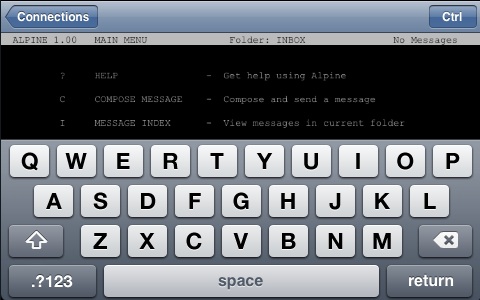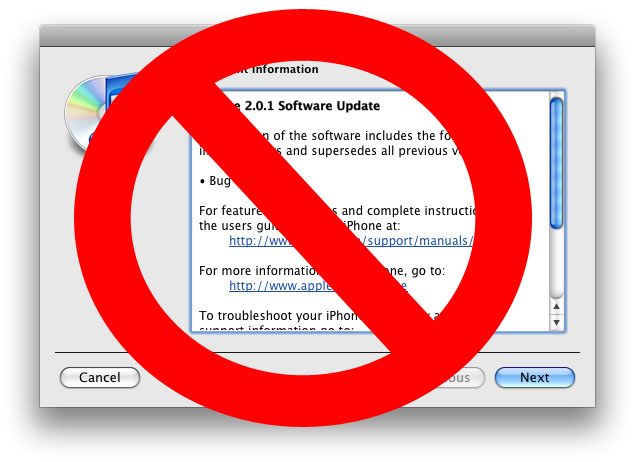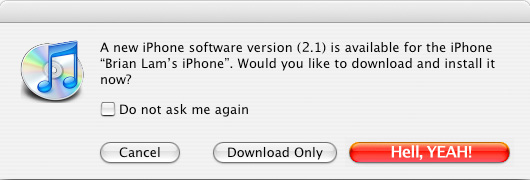News tagged ‘fun’
iPhone 3G: advertising and real world
We all saw iPhone 3G . The funny thing is that in real world everything is much slower than in advertising.
However new iphone 3G is really faster than the old one:
pTerm - terminal application in AppStore

Newly arrived in the App Store is , an iPhone port of the PuTTY terminal emulator. It supports SSH and Telnet, among other things, and has a built-in Control key.
Eric Maland says that a 1.1 update is already on its way (it has been submitted to Apple and is awaiting approval). Unfortunately a handful of "major crashy bugs" (as Eric puts it) were discovered after the 1.0 release had been submitted.
Planned features for future releases include multiple simultaneous connections, custom sizes and colors, port forwarding and lots more.
And in the meantime, if you download and experience crashy behavior, Eric's message is: be patient. The fixes are done, but when they reach the Store is out of his hands.
pTerm is $4.99US in the US
More screenshots and the list of features:
Negative feedback on 2.0.1. Update bricking some iPhones.

Here is some negative feedback on 2.0.1.
- A small number of blog readers and have reported the update bricked their handsets or . Didn't show up during testing by many labs.
- There are several reports that updating to 2.0.1 on an iPhone in Airplane mode may result in bricked phones.
- Users who paid Vodaphone to unlock their phones for international roaming have the update breaks connections with their carriers.
- A few users occasional lag in the Contacts, SMS and e-mail apps. From our testing, typing in the Contacts app is still laggy, but SMS and e-mail is faster.
- No surprise whatsoever: Updating results in losing access to your jailbroken (i.e. hacked) apps. 2.0.1 updates iPhone 3G's baseband, you may never be able to unlock the handset again if you run this update.
- Many users are reporting 2.0.1 is slow with backup. This more likely has to do with the version of iTunes they're running; many have said iTunes 7.7.1 sped up backup and syncing.
Related posts:
Solar powered charging case for the iPhone 3G
There are many solutions like battery packs and rechargeable hip holsters for iPhone and iPhone 3G. However, the new case from Mobile Fun has one advantage over all of these other devices—it can be charged by the sun.
The case itself features a sizable 1500mAh battery pack that they claim can be charged by the sun in as little as three hours. It also has a mini USB to USB cable that allows you to charge from your PC or hook up other gadgets for a quick shot of sweet solar juice. The case is slated for release in August in both black and white versions for around $54.
Installing 2.0.1. Solving problems. Avoid bricked phone.
Here is an . If you want to install please read this first:

Disable airplane mode before installing Prior to installing the iPhone OS 2.0.1 update, make sure that Airplane mode is not enabled on your iPhone. Having Airplane mode turned on can result in a non-functional phone when the update is applied. You may receive the error message:
“Information for activation cannot be obtained from the iPhone”
Fortunately, you can disable Airplane mode from the emergency screen if your iPhone is put into an inactivated state by a problematic update.
“iTunes could not update the carrier settings on your iPhone” Several users are receiving the error message “iTunes could not update the carrier settings on your iPhone. An unknown error occurred (OxE80000001).”
If this error occurs, try clicking the “Restore” button in iTunes rather than “Update.”
Problems installing:
Quake for iPhone 2.0

Quake filannly made it! It is avaliable in Cydia Installer.
Main thing, it’s quite playable - moving around and firing are easy to do. There is an Options area, sound and music, and very little lag when playing. It doesn’t make use of the accelerometer - but if you’re a Quake fan, this is a good bit of Sunday fun for sure.
Free VoiceNotes Recorder in AppStore [AppStore, Free]
It is called EccoNote. iTunes link is . It is simple. The main purpose is to recoed something and be able to playback. In the future developers promise to add additional functionality: f.e. sending recorded tracks via email. And it is free ![]()
WinterBoard - themes for 2.0
Winterboard for firmware 2.0 provides some of the functionality that SummerBoard provided. However it looks like it will be much much more in the near future. Currently the settings dialog just allows you to select your theme, but you can expect this to be expanded in the future. (Note: the configuration GUI is not done yet).
At the release of Winterboard, many themes were also released into Cydia. All of our Summerboard themes are now available for use.
Winterboard does more than SummerBoard. It will theme many more elements of your UI. You can theme the battery images and other graphics. There is support for theming inside of .artwork files. It will open the door for themes to become full iPhone themes changing the color of your alerts, graphics in apps, and all sorts of amazing things!
 Leave a comment, read comments [1]
Leave a comment, read comments [1]
IPhone Backup Disabler v1.1

TwelvePin has released the Backup Disabler, a new iTunes utility for Mac OS X. Backup Disabler allows users to turn off iTunes 7.7’s backup feature for the iPhone and iPod touch. The application also allows this functionality to be restored, both with a single click.
The balance between backing up that your latest saved game or text messages and waiting an hour for your phone to sync is a delicate one. Now, you can easily sync without waiting for the backups, and just as easily re-enable them whenever you like. Backup Disabler works by setting a hidden iTunes preference to turn off syncing, as shown .
10 things we want to see in the iPhone 2.1 Update

The iPhone 2.0 software is pretty good. We like the App Store a lot; it adds a boatload of new functionality to the iPhone. But it's certainly not perfect. Having used it for a few weeks, we've discovered a number of little quirks that we really hope are addressed in the upcoming update. From bugs to missing features, here are ten things that would make the iPhone a much more attractive device.
1. Make it Less Crashy
The iPhone with 2.0 software feels a little… buggy. It'll randomly crash or slow down to the point of unusability until you restart every few days with normal use. That's not right; this is a cellphone. It shouldn't feel like an unstable computer.
Car Performance Meter for IPhone
This is one of the most interesting applications for IPhone.
Dynolicious is an all-purpose automotive performance meter, utilizing the built-in accelerometer in the iPhone and iPod touch to record your driving characteristics. BunsenTech, the makers of the software, claim that it can record 0-60 times within .08 of a second, accurately estimate your current speed and monitor and record any directional G force. The system seeks to perform nearly every function of (much) more expensive dedicated monitoring units, which seems like an awfully tall order for a $12.99 piece of cellphone software.
Specifically, the Dynolicious software gives you:
- 0-60 MPH
- Other Speed Tests (0-10 MPH through 0-100 MPH in 10MPH increments)
- Quarter Mile Elapsed Time
- Quarter Mile Trap Speed
- Elapsed Time and Trap Speed for standard intervals (60', 330', 1/8 Mi, 1000')
- Lateral G's (current and peak)
- Braking G's (current and peak)
- Wheel Horsepower
- Estimated Engine Horsepower
- Realtime Speedometer and Graphs
- Realtime graphical skidpad display
- View results for latest test run or any saved run
- View averages based on vehicle, date, or modification
- Compare results between vehicles, dates, or before-and-after modifications
More screenshots:
MagixPad - notes app with copy/paste
This video walkthrough of MagicPad, a rich text editor app that is still pending acceptance into the App Store, is notable for showing the first working copy and paste framework on the iPhone (at the 1:00 mark). Of course, SDK limitations keep the functionality quarantined within MagicPad itself, but its developers, Proximi, hope to use it as a case study for pushing forward one of the iPhone software's most wanted features.
via gizmodo
Related posts:
BossPrefs for 2.0 firmware
![]()
BossPrefs is a very popular allpication. Now there is BossPrefs v2.0.2a that works with 2.0 fimware. It can be installed via Cydia Installer.
This is the first working version for 2.0 devices. There will be some issues but the major stuff should work. The airplane / phone toggles are not implemented, the add plugin GUI is not implemented, and there may be some other minor issues. The bulk of it works. Update will be very soon, but we can use this version right now.
Couple words and screenshots for those, who are not familiar what this application is for:
Safari benchmark - 2.0 is faster than 1.1.4
There is not much defference between Safari 1.1.4 and 2.0. But Under the hood, MobileSafari 2.0's performance is hugely improved over 1.1.4. Everything related to web surfing feels faster, web pages consistently load faster on 2.0, both via Wi-Fi and EDGE. This has nothing to do with the new iPhone 3G hardware — this is about dramatic performance improvements on original iPhones upgraded to the 2.0 OS.
Using MobileSafari simply feels faster, especially with web applications. Feel is by nature subjective, but JavaScript benchmarks back this up.
In August last year, to compare the iPhone's processing power and JavaScript interpreter against Safari 3 running on a Mac with a 1.83 GHz Core Duo. At that time, the current version of the iPhone OS was 1.0.1. Here are the results of those same benchmarks on original iPhones running the 1.1.4 and new 2.0 OS versions, with Hockenberry’s 1.0.1 results included for comparison:
| Test | 1.0.1 | 1.1.4 | 2.0 | Vs. 1.0.1 / 1.1.4 |
|---|---|---|---|---|
| 100,000 iterations | 3.209 | 1.096 | 0.145 | 22× / 8× |
| 10,000 divisions | 0.413 | 0.181 | 0.029 | 14× / 6× |
| 10,000 sin(x) calls | 0.709 | 0.373 | 0.140 | 5× / 3× |
| 10,000 string allocations | 0.777 | 0.434 | 0.133 | 6× / 3× |
| 10,000 function calls | 0.904 | 0.595 | 0.115 | 8× / 5× |
The last column shows how many times faster the 2.0 version of MobileSafari was versus 1.0.1 and 1.1.4. The same results, charted (smaller bars are faster) can be viewed above.
The results are obvious. WebKit JavaScript performance has improved steadily and significantly in just one year, with a huge jump between 1.1.4 and the new 2.0.0. In side-by-side page loading tests between two original iPhones running 1.1.4 and 2.0.0, the new version consistently finished at least a few seconds faster.
For all the hubbub regarding the new App Store, most “iPhone software” runs in the web browser. But improvements in WebKit performance often help native iPhone app performance, too — a slew of my favorite native iPhone apps have built-in WebKit browsers (e.g., NetNewsWire, Twitterrific, Instapaper, and Cocktails). When WebKit performance improves, any app that uses WebKit improves, and WebKit improved a lot between iPhone 1.1.4 and 2.0.0.
via daringfireball.net
AT&T tests IPhone 3G 's GPS
Larry Meyer from AT&T testdrives GPS functionality on IPhone 3G.